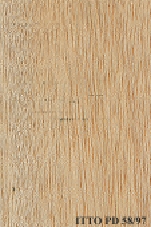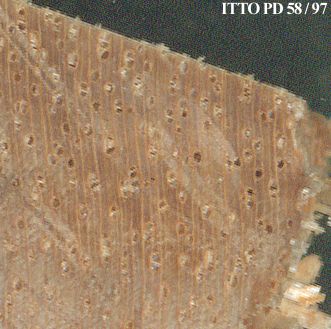
ANABIONG (Trema orientalis)
Trade Name
Anabiong
Scientific Name
Trema orientalis (Linn.) Blume
Family
ULMACEAE
Common Names
Anabiong (Philippines)
Description Of The Tree
Botanical Description
It is a medium to large sized tree, growing in the average 20 meters and attaining diameters of 60 cm at breast height. The bole is fairly straight, with no buttresses.
Natural Habitat
It is a very common tree in the Philippines, growing abundantly in open dry brushland and waste places at low and medium elevations.
Non Timber Uses
The bark of this species is reported to contain tannins.
Wood Identification
Anatomic Description Of Wood
Wood diffuse porous. Tangential diameter of vessel lumina 200 micras or more (large). Paratracheal axial parenchyma scanty and/or vasicentric. Body ray cells procumbent with over 4 rows of upright and/or square marginal cells (Kribs-I).
-
 Wood Macro Photo Tangential Plane
Wood Macro Photo Tangential Plane
-
 Wood Micro Photo Of Transversal Section
Wood Micro Photo Of Transversal Section
Availability
Cites Status
Unrestricted
General Wood Description
Odor
No odor or taste are reported for this species.
Color
The sapwood is not distinct from the heartwood which is buff or straw colored.
Grain
It has straight or interlocked grain.
Texture
Texture is reported to be fine to medium.
Luster
It is reported to be lustrous.
Natural Durability
It is sensible to pin hole borers and probably to termites attack.
Natural durability index (1= Very high durability, 7=Vey low durability)
5
Resistance To Impregnation
The heartwood is resistant to impregnation, but the sapwood can be readily treated.
Wood Physical Properties
Basic Density or Specific Gravity (O.D. weight/vol. green) (g/cm³)
0.37
Air-dry Density (Weight and volume at 12%MC) (g/cm³)
0.39
Total shrinkage Tangential (Saturated to 0%MC) (%)
6.3
Total shrinkage Radial (Saturated to 0%MC) (%)
3.3
Drying Defects
Ease of Drying: Liable to develop long, fine, deep cracks if cut to wide sections, green conversion to smalll size and stacking under cover recommended.
Dimensional stability ratio (Total Tangential Shrinkage %/Total Radial Shrinkage %)
1.9
Wood Chemical Properties
Wood Mechanical Properties
Bending Strength (MOR),12%MC (kgf/cm²)
558
Stiffness (MOE) 12%MC (kgf/cm²)
87067
Compression parallel to fiber 12%MC (kgf/cm²)
274
Compression perpendicular to fiber 12%MC (kgf/cm²)
47
Shear strength radial 12%MC (kgf/cm²)
71
Janka hardness (side) 12%MC (kgf)
250
Janka hardness (end grain) 12%MC (kgf)
343
Workability
Sawing
Sawing of this species is reported to be rather easy.
Rotary Veneer Cutting
This timber can be used for lamination.
Sliced Veneer
This timber can be used for lamination.
Blunting Effect
Some blunting effect on the cutting elements is reported for this species.
Machining
This species is easy to machine. It works well with most machine tools.
Finishing
This species has a fair behavior in finishing.
REFERENCED USES
End Uses Summary
PACKING, OTHER AND MUSICAL INSTRUMENTS, handicrafts, shoes, particleboard, paper
Packing
- 45 - Recopilación y Análisis de Estudios Tecnológicos de Maderas Peruanas
Handcraft
- 66 - Maderas latinoamericanas. VII. Caracteristicas anatomicas. propiedades fisicomecanicas, de secado, y tratabilidad de la madera juvenil de Cordia alliodora (Ruiz & Pav. Oken.)
Shoes
- 70 - Proprietes physiques et mecaniques des bois tropicaux de l`union francaise
Particleboard
- 80 - Estudio Integral de la Madera para Construcción
Paper
- 82 - Compilation of Data on the Mechanical Properties of Foreign woods (Part 2) Central and South America.
Please Provide Information To View Producer Information